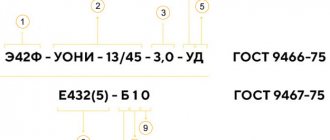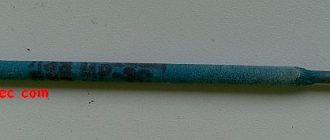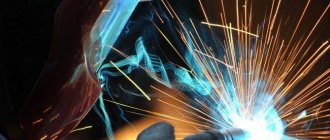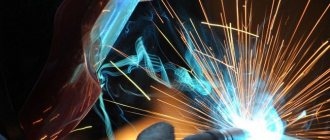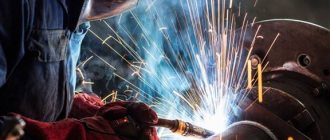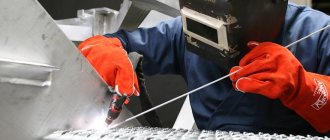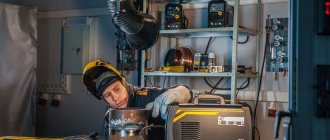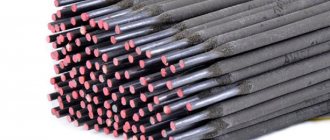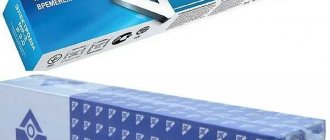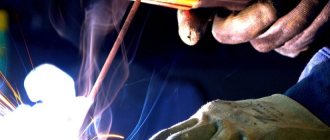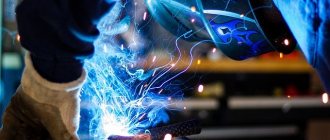Welding is one of the most important crafts for humans. Thanks to discoveries in this area, we can realize any, even the most daring ideas: from making swing gates to designing spaceships. There are many types of welding, including industrial, but among them it is manual arc welding that is most widespread. This is a simple and understandable technology that you can learn on your own.
The modern market offers different types of electrodes for manual arc welding, which are difficult for novice welders to understand. In this article we will tell you what types of electrodes there are for manual arc welding and how to choose them based on your tasks.
The essence of manual arc welding
Before we talk about electrodes, let's understand what manual arc welding is. An arc is a flow of particles formed during the ionization of the anode and cathode. The ionization process itself is formed by the interaction of current and short circuit. At the same time, the welding process is also influenced by the composition of the electrode coating and oxygen obtained from the atmosphere. Together, these processes lead to heating of the arc and the release of a large amount of heat, sufficient to melt the edges of the parts being welded. The edges then cool, forming a strong and reliable seam.
The key element in this process is the electrode. Without it, it is impossible to ignite the arc and keep it burning. Welding can be done using one or more arc welding electrodes. There is no single classification of rods, since the types of electrodes for manual welding can be divided into many small categories: from purpose to materials of manufacture. By the way, the electrodes themselves for electric arc welding can be made not only from metal, and we will talk about this later.
Electric arc characteristics
An electric arc, which is formed using a welding machine, is, in fact, an electrical discharge flowing in a gas environment. The electric current that moves in it receives this opportunity due to the presence of an electric field in it. For the purpose of streamlining terminology, such an arc is usually called a welding arc.
The welding arc, which is the main element of the formed electrical circuit, is characterized by a decrease in voltage. If the welding electrode is connected to the positive terminal of the welding machine, it is called an anode, if it is connected to the negative terminal, it is called a cathode. When performing electric arc welding using alternating current, the cathodes and anodes alternate places.
The most important parameter of the welding arc is the distance between the interacting electrodes. Such a gap through which electric current flows is called an arc. The flow of electric current through such a gap is possible only if it contains charged particles - electrons and ions. Initially, naturally, such particles do not exist in this interval. For them to appear, the ionization process must be started.
Arc Welding Structure
Ionization of the arc gap occurs as follows: electrons begin to be emitted from the surface of the cathode, which charge the vapors and gases formed above the weld pool. The welding arc is:
- compressed type (its cross-section can be changed using the nozzle of the welding machine, the magnitude of the electromagnetic field, and gas flow parameters);
- free (it is also called a direct arc - the parameters of an arc of this type are not adjustable, they are unchanged).
Brief classification of electrodes
As we wrote above, it is difficult to classify electrodes according to only one parameter. But basically, all rods are primarily divided by the type of material from which they are made, as well as by coating (or coating). Here is a brief classification of electrodes:
- Melting electrodes. They are made from metal, such as cast iron, aluminum, steel or copper. The material from which the electrode is made is selected in accordance with the metal that needs to be welded. Consumable electrodes are both anode and cathode. This is the most common type of rod at the moment.
- Non-consumable electrodes. Made from coal, graphite or tungsten. They are used in conjunction with welding wire, because such rods are not capable of forming a welding seam. When using carbon rods, use straight polarity instead of reverse polarity. Tungsten rods are indispensable for argon arc welding due to their high melting point, but are rarely used in manual arc welding.
- Electrodes without coating or coating. They are used in conjunction with flux, which is continuously supplied throughout the welding process. For manual arc welding, such rods are not used.
- Coated or coated electrodes. The most common electrodes on the market. The coating of electrodes for manual arc welding performs several functions at once: protects the metal from the negative effects of oxygen, ensures stable arc burning, and improves the quality of the welded joint. Such electrodes are used not only for manual arc welding, but also for semi-automatic and automatic ones.
Step-by-step instructions for beginners
Start by preparing your work area. There should be no flammable or combustible substances nearby. The floor in the room can be concrete or earthen. It is best to weld structures outdoors or in a well-ventilated, large space. There should be fire extinguishing equipment and a first aid kit nearby. Now let's move on to the stages of learning how to learn how to weld with a welding machine.
External inspection of equipment
An external inspection of the welding inverter is carried out by the welder himself before the start of each work shift. During this procedure, the condition of the insulating sheaths of the welding and supply cables is first checked and, if necessary, they are replaced or repaired. Next, the electrode holder and the ground cable clamp are checked, as well as the condition of the plugs and sockets for connecting to the welding inverter. The next step is to inspect the welding control panel for the integrity of toggle switches, switches, buttons and indicators. In addition, the overall dust content of the device is determined and, if necessary, it is cleaned.
Machine modes and welding parameters
Experienced welders know how to weld thin metal by testing a variety of machine settings. As a result, optimal parameters were derived that are well suited for this type of work. Here are the main settings:
| Metal thickness, mm | Current strength, A | Electrode diameter, mm |
| 0.5 | 10 | 1 |
| 1 | 25-35 | 1.6 |
| 1.5 | 45-55 | 2 |
| 2 | 65 | 2 |
| 2.5 | 75 | 3 |
It is important to set the welding current lower than when working with thick plates. This will help avoid burns and leaks. Inverters that allow cooking with alternating voltage but at high frequencies, as well as direct current devices, have proven themselves to be excellent in this area.
If the unit settings allow you to set the starting voltage level, then you should take advantage of this and set a lower value (by about 20%) than the operating current. This will prevent the area from being scorched when starting to ignite the arc and will help to start welding immediately at the joint. If the starting current is not regulated, then you can ignite the electrode on a thick surface and then transfer it to the joint.
Welding thin metal involves working at low currents. To do this, the inverter settings must support the operating values of the ammeter at 10-30 A.
If the minimum adjustable value is higher than these parameters, then it is possible to reduce the current strength with additional resistance in the circuit. For this, a high-carbon steel spring is used, placed between the product and the ground cable.
Installing an additional ballast that reduces the current to the required level will also help.
If the device settings support the pulse mode, then you can use this. Especially thin steel is welded with an intermittent arc. The pulsed current will automatically break the arc, allowing the metal to cool.
How to connect the electrode
Insert it into the holder; it should not wobble. Then connect the two welding cables. They have different markings (plus and minus). A positive charge is applied to the part (using a clamp), and a negative charge to the electrical conductor. This polarity increases the heating of the metal.
In the article we told you how to learn how to weld from scratch yourself.
Use of protective equipment
When carrying out welding work, the greatest danger is the possibility of electric shock, burns from flying drops of molten metal and light exposure to the retina of the eye from the radiation of an electric arc. In addition, mechanical injuries and gases released during the welding process may enter the respiratory tract. Therefore, any novice welder who decides to master a welding inverter, in addition to the machine itself, is required to purchase a set of personal protective equipment, as well as carefully study the safety rules when performing welding work. The standard set of welder protective equipment includes a mask and spark-resistant gloves, as well as overalls and shoes made of non-flammable and non-melting materials. In addition, during welding with an inverter, a special respirator may be required, and the cleaning of workpieces and seams must be done using safety glasses.
Start of welding: light the arc
An electric arc is created independently when polarly charged elements come into contact in two ways:
- by striking - draw a strip along the joint;
- tapping - tap 2-3 times on a place where the mark is not important.
If a spark does not form immediately, you need to cut off the excess winding. We can continue to work.
Incline
Tilt the electrode in your direction at an angle in the range of 30-60 degrees. This ensures good heating of the slag bath. But in some cases this is not necessary, then they use the “backward angle” method, that is, away from themselves, then the seam stretches behind the tip of the protective coating.
How to learn to use welding and determine the speed of movement
You cannot tightly attach an electrical conductor to a metal structure; there should be 2-3 mm between them, this distance is necessary to form a slag bath. How quickly to perform manipulations depends on the voltage and degree of heating; usually this is an individual indicator; it can be determined by the degree of heating and heating upon contact.
Current setting
Correct selection of the current value of the welding inverter is the key to the quality of the weld. In order to select a value corresponding to the thickness of the metal and the diameter of the electrode, it is best for a novice welder to use the corresponding table from the inverter passport. After this, you need to turn on the device’s power switch, and then, by turning the regulator, set the required current value. For some devices, the scale of its values is marked on the front panel of the inverter along the arc of rotation of the regulator, for others it is displayed on a digital indicator (see photo below).
In any case, this will be an approximate value, so it is quite possible that the current strength for good penetration will have to be adjusted during the process of making test welds.
How to weld parts correctly
Before starting the process, you need to create temporary fastenings - ties, rivets. They will allow you not to pull the structure to one side so that it does not deform. Then the seam will be smooth, and the shape will be the way it was intended. Only after this can you begin to take active action.
Current selection
It always depends on the type of metal connections and the electrode. If the voltage in the home network is not enough for the required strength, you can go through two layers or work more slowly to achieve the optimal temperature. Table of correspondence:
| Electrode diameter, mm | Metal thickness, mm | Welding current, A |
| 1,6 | 1-2 | 25-50 |
| 2 | 2-3 | 40-80 |
| 2,5 | 2-3 | 60-100 |
| 3 | 3-4 | 80-160 |
| 4 | 4-6 | 120-200 |
| 5 | 6-8 | 180-250 |
| 5-6 | 10-24 | 220-320 |
| 6-8 | 30-60 | 300-400 |
Making various seams
Depending on their location, the seams can be vertical, horizontal, ceiling, or inclined.
Making a seam:
- prepare the plates;
- turn on the inverter, set the current;
- make a small gap between the plates, create weld pools;
- make a welding connection;
- beat off the slag.
Each seam is made using this algorithm, but in the photo you can see visual differences in the process.
Depending on the design of the connection, the seams can be butt, tee or overlap. You can learn how to make seams experimentally, using detailed photo instructions as a guide. Welding will become beautiful over time. The main thing is to start and try to work with hardware.
Types of electrodes by purpose
Depending on the metal being welded, the operating mode of the welding machine and electrodes are selected. Different metals require different electrodes, this is called purpose. The purpose is indicated by one letter on the packaging and on the rod itself.
Electrodes marked “U” are used for welding low-alloy and carbon steels. The letter “L” denotes rods used for welding alloyed structural steels, and for high-alloy steels the designation “B” is used. The letter “T” denotes rods for heat-resistant metals, and the letter “H” denotes rods for surfacing.
Types of coatings for electrodes
Along with the material of manufacture and purpose, the type of electrode coating is also selected. The choice of coating also depends on the metal being welded. The coating (or coating) performs a protective function. When the electrode melts, the coating releases protective substances and slag, which improves the quality of the seam and produces reliable and durable welded joints. Manufacturers use the following types of electrode coatings:
- Acid coating. Marked with the letter “A” on the packaging and the electrode itself. Used for highly targeted applications, such as bottom welds. Can be used with both AC and DC current.
- Rutile coating. Marked with the letter "P". One of the most popular coatings among both beginners and professionals. Compared to other coatings, it is almost non-toxic and provides good quality seams. When burned, it forms slag with protective properties. The composition can be varied, but the base is always titanium dioxide or simply rutile. Hence the name.
- Cellulose coating. Marked with the letter "C". Suitable for making any welded joints, ensures good quality of the seam, but at the same time contributes to strong metal spattering. We recommend using cellulose-coated electrodes when welding pipelines, since the disadvantages are not critical in such work.
- Basic coating. Denoted by the letter "B". The most popular type of coating along with rutile. Simulates gas welding due to the release of carbon dioxide when the arc burns. We recommend using base coated rods only in combination with direct current and reverse polarity. If you use alternating current, the weld will be of poor quality and additional measures will be required to improve the strength of the seam.
- Other types of coatings. Marked with the letter "P". The composition contains alloying substances. Thanks to this, the quality of the seam improves. In general, other types of coatings are used the least often.
- Special types of coatings. They are designated by the letter “C” or the inscription “special” on the packaging. They are used for complex welding under water, since they contain liquid glass and resin-containing substances.
As you can see, electrodes are selected based on specific tasks. For manual arc welding, rutile-coated rods are most often used because they are universal.
Electric arc welding equipment
For electric arc welding, it is enough to have a traditional transformer machine. This is a long-known classic welding equipment. The principle of its operation is simple: the transformer lowers the voltage while increasing the current. The equipment is designed to operate with an alternating current source. But such installations have critical disadvantages: large size and weight. It is inconvenient to move both to the work site and during the welding process. To make things easier, specialists install equipment on mobile platforms. But this is of little help, since the dimensions are only increasing and the equipment is becoming less agile.
In cases where mobility and performance are required, a converter is the way out. The operation of the installation is to convert alternating household current into high frequency. After that, it transforms into a permanent one. The units are characterized by compact dimensions and low weight. The inverter is characterized by a stable electric arc, which has a positive effect on the quality of the seam. It provides the ability to work with current of direct or reverse polarity.
Selecting the electrode diameter
Most novice welders classify welding rods by diameter, which is correct. After all, the diameter of the electrode directly depends on the thickness of the part. And even if you choose a rod with the right coating and from the right material, but the size is wrong, you will not get a quality seam.
The diameter of the electrode is indicated in millimeters on the packaging or on the rod itself. In this case, the length of the electrode also depends on the diameter. For welding at home, arc welding electrodes with a diameter of 2 to 4 mm are usually used. This is a universal size suitable for most welding jobs. Thicker electrodes are used in factories or private workshops.
Security measures
When performing electric arc welding, the following safety precautions must be observed:
- It is imperative to wear protective clothing and shoes made of thick material. These products can protect the body from hot metal, which can cause severe burns. The sleeves must be buttoned tightly, and gloves must be worn on the hands.
- If you don’t have a protective uniform, you can use cotton clothing instead.
- From bright light and sparks from hot metal, your face and eyes must be covered with a protective mask.
- Welding work must be performed in ventilated areas.
- Before starting work, it is recommended to prepare water or a fire extinguisher. Hot metal particles and sparks can lead to a fire, so all means to prevent it should be at hand.
Note! Safety precautions must be strictly observed. If this is not done, you may inadvertently suffer serious injuries during the welding process.
Electric arc welding is a popular technology that is excellent for welding different types of metals. The process must be carried out correctly in compliance with important principles. The work needs to be done in stages, this will allow you to develop an even and durable seam. But don’t forget about the necessary safety measures that will protect you from injury and help you do everything right.
Selection of electrodes depending on the type of seam
It is also advisable to select electrodes for manual arc welding according to the type of seam with which you are going to weld metal. In addition to the standard horizontal, vertical, inclined and angled seams, there are also oblique, butt, beveled and many others. This is more useful for experienced welders, but novice welders should also know this information. Now let's talk about what types of electrodes there are for manual arc welding.
Electrode grades suitable for manual arc welding
There are also types of electrodes for manual arc welding, divided by brand. The brand of electrode you use also depends on the metal you need to weld.
The following grades are used for welding low-alloy carbon steels:
- E42: grades ANO-6, ANO-17, VSC-4M.
- E42: UONI-13/45, UONI-13/45A.
- E46: ANO-4, ANO-34, OZS-6.
- E46A: UONI-13/55K, ANO-8.
- E50: VSC-4A, 550-U.
- E50A: ANO-27, ANO-TM, ITS-4S.
- E55: UONI-13/55U.
- E60: ANO-TM60, UONI-13/65.
For welding alloy steels (including high-strength):
- E70: ANP-1, ANP-2.
- E85: UONI-13/85, UONI-13/85U.
- E100: AN-KhN7, OZSh-1.
- E125: NII-3M, E150: NIAT-3.
For metal surfacing: OZN-400M/15G4S, EN-60M/E-70Kh3SMT, OZN-6/90Kh4G2S3R, UONI-13/N1-BK/E-09Kh31N8AM2, TsN-6L/E-08Kh17N8S6G, OZSh-8/11Kh31N11GSM3YuF.
For welding cast iron: OZCh-2/Cu, OZCh-3/Ni, OZCh-4/Ni.
For welding aluminum and its alloys: OZA-1/Al, OZANA-1/Al.
For welding copper and its alloys: ANTs/OZM-2/Cu, OZB-2M/CuSn.
For welding nickel and its alloys: OZL-32.
How to choose quality electrodes
Like any welding equipment, electrodes are subject to GOST standards, which regulate their quality. Thus, according to regulations, rods must be made of high-quality materials purchased from certified suppliers.
The coating of electrodes for manual arc welding should not have significant defects; small cracks and dents are allowed due to poor transportation. When melting, the electrode coating should not crumble or melt unevenly, and should also splash within the normal range for each specific type of coating.
The rods must be strong and resistant to mechanical stress. The seam should be of high quality, without cracks or pores. Knowing these features, you can easily choose high-quality electrodes and be confident in the result.
